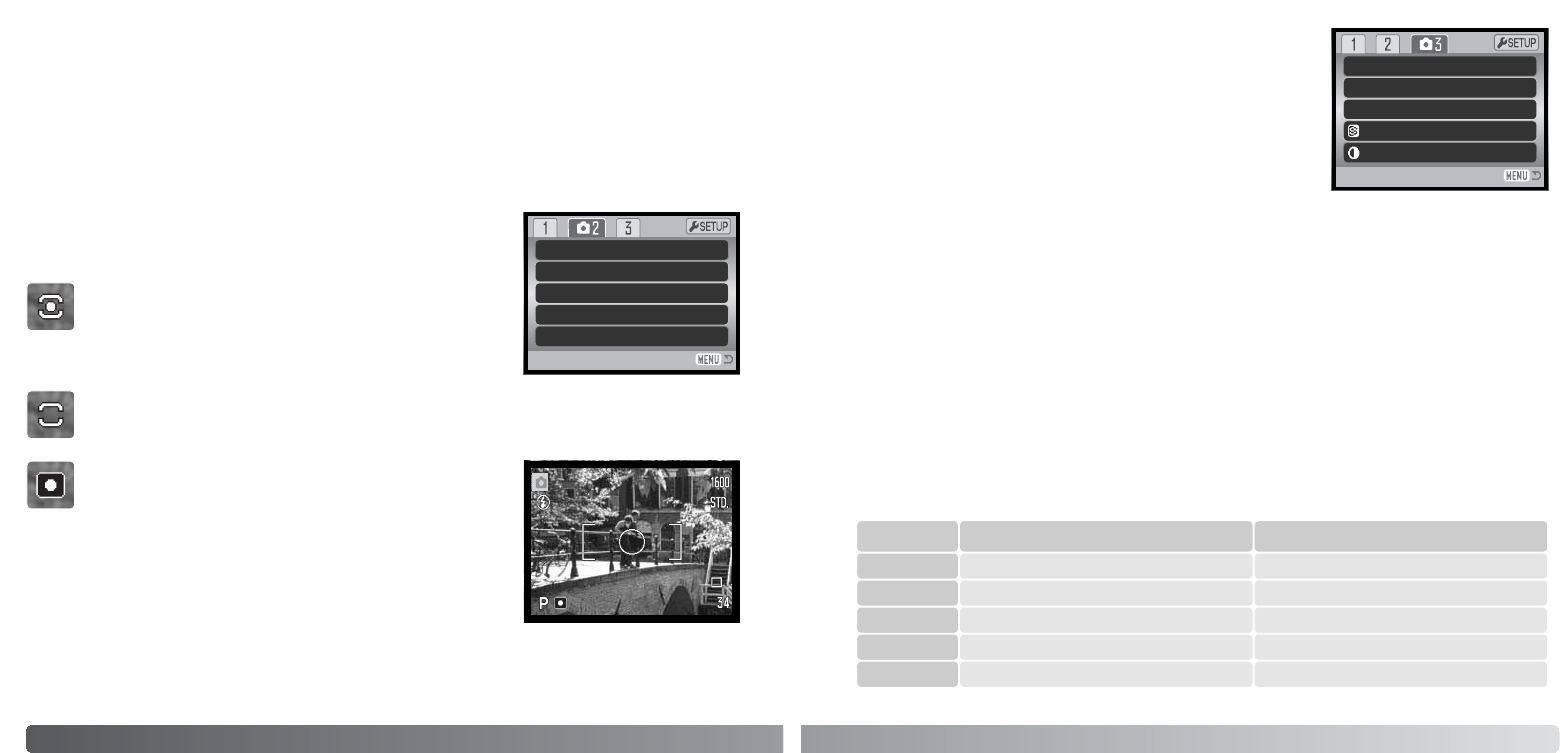
58
A
DVANCED RECORDING
Flash compensation changes the ratio between the ambient and flash exposures. When using fill-
flash to reduce harsh shadows caused by direct sunlight, flash compensation changes the ratio
between the highlights and shadows. The flash affects the darkness of the shadows without affect-
ing the area illuminated by the sun. By decreasing the flash output with a negative Ev setting, the
shadows receive less light and are deeper, but retain detail that would be lost without the flash.
Using a positive Ev setting will soften or eliminate shadows.
Center weighted: a traditional metering method in film cameras. The system measures light
values over the entire image area with emphasis given the central region.
Spot metering: uses a small area within the image to calcu-
late the exposure. A small circle appears in the middle of the
live image indicating the measuring area. The spot allows
precise exposure measurements of a particular object with-
out being influenced by extremely bright or dark areas within
the scene.
Multi-segment metering: uses 256 segments to measure
luminance and color. This data is combined with distance
information to calculate the camera exposure. This advanced
metering system will give accurate worry-free exposures in
almost all situations.
Metering mode indicators are displayed on the monitor. The meter-
ing mode is set in section 2 of the P, A, S, and M menus (p. 44).
Metering modes
Focus mode
Full-time AF
Flash mode
Metering mode
Single AF
On
Autoflash
0
MultiSegment
Flash comp.
59
The flash range is measured from the CCD. Because of the optical system, the flash range is not
the same at the lens’ wide-angle position as it is at the telephoto position.
Camera sensitivity - ISO
Flash range and camera sensitivity
Five camera sensitivity settings can be selected: Auto, 50, 100,
200, and 320; the numerical values are based on an ISO equiva-
lent. ISO is the standard used to indicate film sensitivity: the higher
the number, the more sensitive the film. Camera sensitivity is set in
section 3 of the P, A, S, and M menus (p. 44).
Sensitivity
Digital zoom
Color mode
Contrast
Auto
Off
NaturalColor
Normal
Normal
Sharpness
The auto setting automatically adjusts the camera sensitivity to the light conditions between ISO 50
and 160. When any other setting than auto is used, “ISO” and the set value will be displayed on the
monitor.
A specific sensitivity setting can be selected. As the ISO value doubles, the camera sensitivity dou-
bles. Like grain in silver-halide film that increases with speed, noise increases with sensitivity in digi-
tal imaging; an ISO setting of 50 will have the least noise and 320 will have the most. An ISO setting
of 320 may allow the camera to be hand-held in low-light conditions without the need of a flash.
ISO setting Flash range (wide angle) Flash range (telephoto)
AUTO 0.57 - 4.7m (1.87 - 15.4ft.) 1.57 - 4.7m (5.15 - 15.4ft.)
0.57 - 2.7m (1.87 - 8.9ft.) 1.57 - 2.7m (5.15 - 8.9ft.)
0.57 - 3.8m (1.87 - 12.4ft.) 1.57 - 3.8m (5.15 - 12.4ft.)
0.57 - 5.3m (1.87 - 17.4ft.) 1.57 - 5.3m (5.15 - 17.4ft.)
0.57 - 6.7m (1.87 - 22.0ft.) 1.57 - 6.7m (5.15 - 22.0ft.)
50
100
200
320


















